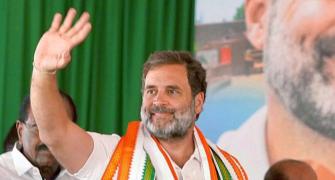The National Democratic Alliance government has tabled a bill in Parliament to send back most of the green tax to the states these have been collected from.
 On October 9, the Supreme Court imposed a green tax on trucks destined for other states but wanting to take a shorter route through Delhi.
On October 9, the Supreme Court imposed a green tax on trucks destined for other states but wanting to take a shorter route through Delhi.
It was to reduce the ambient air pollution in the city which has one of the worst recorded air quality levels in the world.
The decision came 16 years after the court had cleared the plans to build two expressways that were meant to help divert heavy traffic away from Delhi.
The expressways are yet to be built and could take another half a decade, the court was told.
It is arguably the first time such a levy has been imposed for a particular city.
The management of air pollution has always received considerable focus from the Supreme Court since it set up the specialised Environment Protection Pollution Control Authority to advise it.
Since the order, the authority has been in news for trying to implement it through a maze of multiple authorities and private interests.
The Delhi case may have evinced greater media attention but the courts have used their powers through the "polluters pay" principle, the wide flexibility of the Environment Protection Act, 1986 and the principle of providing "complete justice", in such matters to impose green taxes and levies in the past as well.
"In the case of tanneries in Kanpur, the polluting industries in the Taj Trapezium as well as the compensatory afforestation fund, courts have imposed cess and levy to fix and mitigate against environmental damage," says Ritwick Dutta, a Supreme Court lawyer specialising in environmental litigation.
"In the Delhi case, the levy was first ordered by the National Green Tribunal. The law setting up the tribunal expressly provides for imposition of such levies based on the polluter pay principle," he adds.
The biggest pan-India green levy imposed by the apex court across the country was in 2004.
The government used to collect fixed sums from industries and projects wanting to use forest lands.
These funds were to be used for planting trees in lieu of those lost in the process of setting up an industrial plant.
The court found the system had not worked for years.
It imposed an additional net present value of the forests on a fixed slab basis over the existing charges.
It also set up a separate Compensatory Afforestation Management and Planning Authority to manage this fund.
A growing corpus
The fund today adds up to nearly Rs 40,000 crore. In comparison, the annual budget of the Union environment and forests ministry has hovered below Rs 2,000 crore over the last few years.
While forestry is a state subject, the court rejected the contention that the funds should be collected and transferred back to the states where the forest land was to be turned into an industrial site.
The fund authority set up by the government under the approval and supervision of the courts became the manager of the fund.
In 2013, the Comptroller and Auditor General (CAG) presented a scathing report on how thousands of crores in the fund had been grossly misutilised and mismanaged.
This had happened despite the supervision of the apex court and that of another of its permanent expert panel, the Centrally Empowered Committee on Forestry Issues.
The CAG found funds had not been audited for years and there was absolutely no system of reviewing how effectively the money collected by it had been spent in afforestation.
The central fund authority which had representative of the court's expert panel as well as senior officials of the environment ministry had parked over Rs 1,000 crore in different banks that did not even bid for the opportunity to do so .
At times this was done by fixing interest rates with banks on phone personally by senior officials on the authority and at times through handwritten notes from bankers.
The report, which largely missed media attention, led the environment ministry to set up relatively better systems, though it still does not provide a comprehensive overview of how the funds have been spent.
The National Democratic Alliance government has tabled a bill in Parliament to send back most of the funds to the states these have been collected from.
Imposition of the additional net present value, meanwhile, has not dissuaded industry from seeking more forest land - the annual rate of deforestation for development projects has only risen since 2004 as the economy has grown.
"In each of the cases where the courts have had to intervene and create or strengthen such mechanisms, you shall find the state or the Centre had done little while they too had the same powers under the law and the Constitution and were often aware of the environmental damage," Dutta notes.
This is something several environment ministers and politicians have admitted to when asked to comment on judicial activism on green issues, though the executive has also had frequent run-ins with the judiciary over what is termed as judicial overreach.
But, the courts also have had to turn back to the same administrative set-ups and political systems they castigate for lack of inaction to implement these levies and their utilisation for fixing or avoiding environmental damage.
Relying on the old system
A senior official in the environment ministry, wishing to remain off the record, says, "There is some irony in it."
The political economy makes it extremely difficult to put such systems in place, considering the fact that subjects of land, environment and natural resources fall in the concurrent and state lists. Perhaps, a court order is able to short-circuit these dynamics between authorities and various governments to put in place a levy-based environmental mitigation plan.
"But to implement it, the courts can only revert to the same reluctant system to work it out."
"One can also be concerned that the principle idea behind such a levy may be well-intended but the reality of how it shall operate on ground can be far from the ideal," he adds.
He points to other issues where intervention by courts in pushing for specific economic packages and schemes have led to only partial success.
He refers to the myriad orders in the Right to Food case being pursued by the Supreme Court for nearly a decade now.
There the court case led to almost strong reformulation of schemes providing food and nutrition to the poor.
While some of its judgements have found Parliamentary endorsement through the National Food Security Act that the United Progressive Alliance government authored, yet, many of these remain partially implemented, or even ignored.
Instances of judicial activism
Taj Trapezium Case
Filed in 1984. The Supreme Court deployed the “polluter pay” principle and the precautionary principle to make a series of changes including shifting of industries from the corridor around Taj Mahal. The court concluded the polluter pay principle was not only for giving compensation but also fixing and reducing future environmental damage.
Kanpur Tanneries Case, 1987
Did not directly impose a levy but ordered fixing of pollution abatement equipment and treatment systems which hinged on levies charged from the tanneries in order to finance the changes.
CAMPA fund case, 2004
The court ordered an additional net present value to be charged from those using forest land. It set up an authority to manage the fund that has a corpus of around Rs 40,000 crore.










